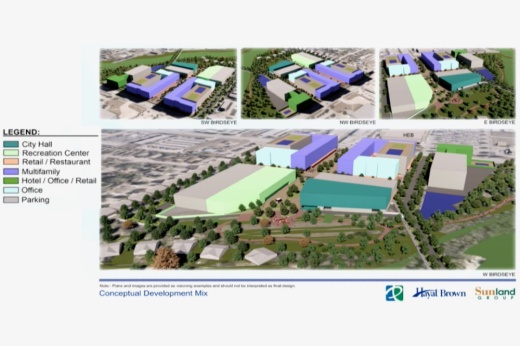At a July 26 meeting, council received a presentation on the project before voting on next steps. The presentation outlined conceptual plans for the project, cost projections and possible funding sources.
According to the presentation, at full build-out the development could include up to 130,000 square feet of retail, 120,000 square feet of commercial, 500 multifamily residential units and 75,000 square feet of hotel.
These estimates represent upper limits and are in addition to the approximately 93,000-square-foot City Hall and approximately 120,000-square-foot recreation center.
During public comment, several residents of the nearby Willow Creek neighborhood expressed opposition to the project with many citing concerns about the density of the development bringing increased traffic, noise and pollution.
"I don't mind a few buildings there, but 500 family units [and] maybe a hotel, offices and retail centers? That's not serving me in any way; that's not serving us over in Willow Creek at all," one speaker said.
Officials emphasized plans for the development are far from finalized and represent only possibilities for what Downtown East could look like.
"I want to reiterate that these are just concepts, and it's very, very helpful to hear some of the things that you would not like, like a hotel [or] an apartment complex," Council Member Rudy Metayer said.
Funding
The presentation went on to discuss funding for the project. The development's cost to the city is estimated to come in at $148.9 million.
The costs break down into $81.4 million for City Hall, $31.5 million for the recreation center, $9 million for public infrastructure and $27 million for public parking.
The $31.5 million estimated for the recreation center represents additional costs beyond the $47.3 million bond approved in 2020.
Of the $148.9 million, an estimated $71.8 million would need to be funded by tax-supported debt with the remainder of the funding coming from alternative sources including a tax increment reinvestment zone, or TIRZ.
The presentation indicates the impact on Pflugerville residents' tax bills would be up to a $3.38 increase per $100,000 valuation.
When fully built out, Downtown East is expected to bring in $1.4 million in annual tax revenue from a combination of property, sales and hotel occupancy taxes.
Public-private partnership and council action
The presentation also included a recommendation that the city enter into public-private partnership, or P3, with a master developer for the project.
A master developer's responsibilities would include assisting in planning and construction as well as leasing commercial spaces.
Jay Brown, a representative for engineering firm Hayat Brown LLC, said entering into a P3 would also mean a developer assumes some of the risk that would otherwise fall on the city.
"All this really does is say we're going to go ask a developer to dance with us and see what they have to offer," City Manager Sereniah Breland said.
Following the presentation, public comment and discussion, council voted 6-1 to accept a five-part recommendation from the Pflugerville Downtown East Community Stakeholder Committee. Council Member David Rogers was the lone "no" vote.
The committee's recommendation included the following pieces:
- Proceed with solicitation of a master developer for the creation of a P3.
- Prepare and issue certificates of obligation not to exceed $72 million in tax-supported debt.
- Proceed with an expansion of TIRZ No. 1 and allocation of funding.
- Establish a cost recovery model for maintenance and operations of the new recreation center.
- Request the Pflugerville Community Development Corp. allocate funding to support the project.
More information on Downtown East is available on the city's website.





